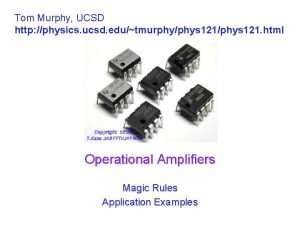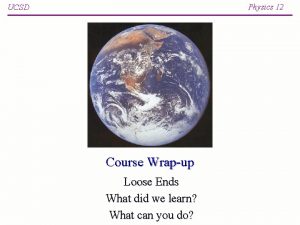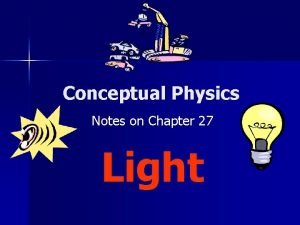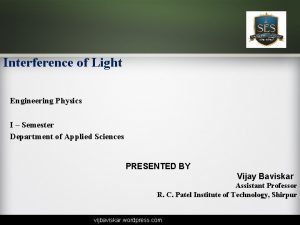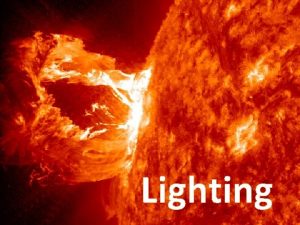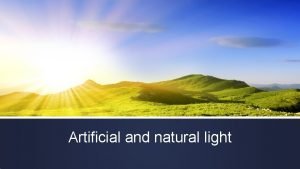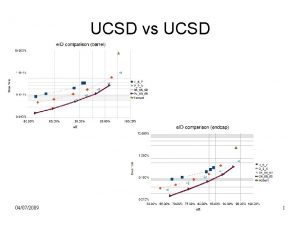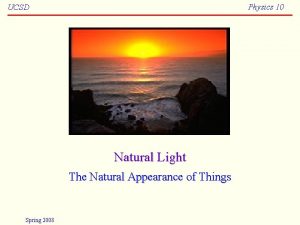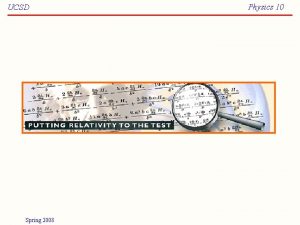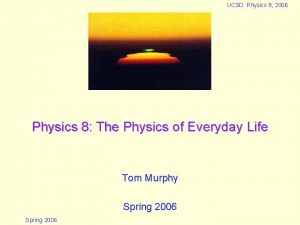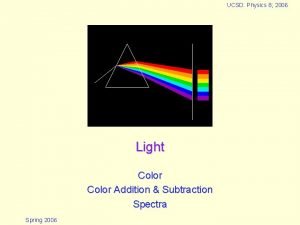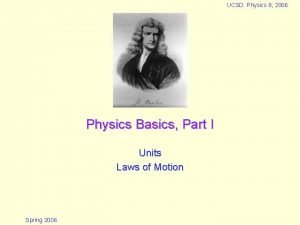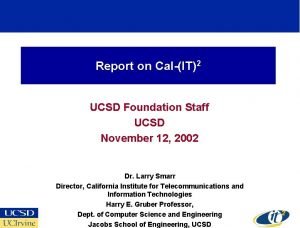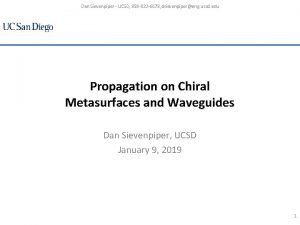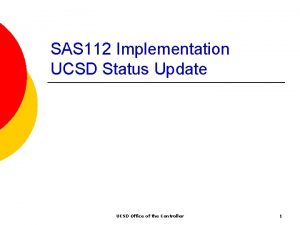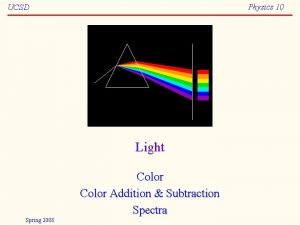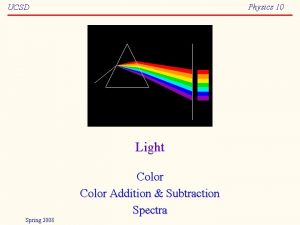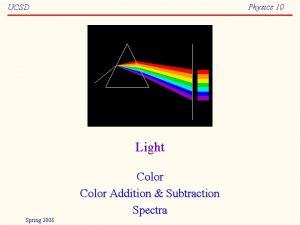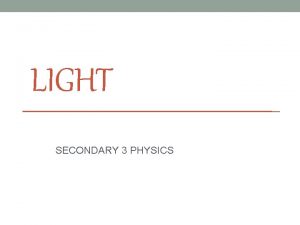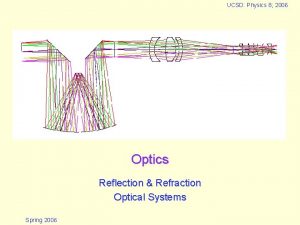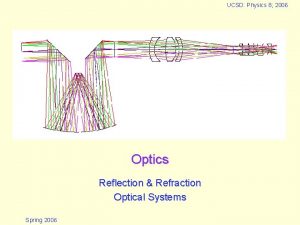UCSD Physics 8 2006 Natural Light The Physiology






















- Slides: 22

UCSD: Physics 8; 2006 Natural Light The Physiology of Color The Natural Appearance of Things Spring 2006

UCSD: Physics 8; 2006 Linear spectrum vs. color wheel • The spectrum spanning blue to red wavelengths has been thus far portrayed on a linear scale • Nature also prefers this scheme – prisms, rainbows, wavelengths, extension to IR, UV, … • But we can draw a color wheel—what’s up w/ that? Spring 2006 2

UCSD: Physics 8; 2006 Color wheel physiology • Color wheel is purely a physiological phenomenon – receptors in our eyes are cyclic in nature – red/green receptor and blue/yellow receptor – best experienced via afterimages (demo) • Red/green receptor fires more for green, less for red – Hering proposed “opponent” color scheme, in which, for instance, red light inhibits the red/green receptor, while green light stimulates receptor. – Nicely accounts for afterimage phenomenon, but some maintain that color perception is trichromatic, with separate red, green, and blue receptors Spring 2006 3

UCSD: Physics 8; 2006 Opponent Color Receptor Theory Spring 2006 4

UCSD: Physics 8; 2006 Why do things look the way they do? • Why are metals shiny? – Recall that electromagnetic waves are generated from accelerating charges (i. e. , electrons) – Electrons are free to roam in conductors (metals) – An EM wave incident on metal readily vibrates electrons on the surface, which subsequently generates EM radiation of exactly the same frequency (wavelength) – This indiscriminate vibration leads to near perfect reflection, and exact cancellation of the EM field in the interior of the metal—only surface electrons participate Spring 2006 5

UCSD: Physics 8; 2006 What about glass? • Why is glass clear? – Glass is a good insulator electrons stay home – Electrons are not easily vibrated, until energy increases to UV – Also absorbs infrared: greenhouses retain heat (IR) Spring 2006 6

UCSD: Physics 8; 2006 What about white stuff? • Why is ice clear, but snow white? – Ice in bulk is much like glass; light passes right through – Tiny facets in snow reflect and refract light, presenting your eye with bewildering array of light from all directions: takes on appearance of ambient light – Salt is the same: crystal is clear, grains look white – Take sandpaper to Plexiglass, or scratch clear ice with skate to see the criticality of surface conditions – Frosted glass another good example of surface scattering Spring 2006 7

UCSD: Physics 8; 2006 And More Questions… • Why are raindrops on the sidewalk dark? – Water mediates surface roughness by filling in all the nooks and crannies – See into sidewalk better, without bewildering scatter – Same as rubbing oil on scratched Plexiglass, waxing car, applying lotion to scaly skin • Okay, if insulators are naturally clear/translucent, then why aren’t all insulators clear (paper, plastic, wood, rocks, etc. ) – Hmm. Tough one. Muddy water isn’t clear, which is related. Colloidal suspensions of junk get in the way, absorbing light – Surface texture also important (try wetting paper—it becomes semitranslucent) – Dyes and pigments selectively absorb, and are embedded in material Spring 2006 8

UCSD: Physics 8; 2006 Why are soap bubbles & oil slicks colorful? • A thin film reflects light from both the top and bottom surfaces • Imagine the film is comparable in thickness to the wavelength of light – perhaps a few wavelengths thick • The two reflected waves may add constructively or destructively • But this is very wavelength-dependent – if red combines constructively, that doesn’t mean blue will too • Also very angle-dependent – color appears to change with viewing angle Spring 2006 9

UCSD: Physics 8; 2006 Why is the sky blue? • Blue light more readily “scattered” by air molecules – called Rayleigh Scattering; strong function of wavelength – blue light in sky has been diverted from some other path – with some blue light missing, sun looks yellow/orange Spring 2006 10

UCSD: Physics 8; 2006 The spectrum of the blue sky The sky (blue curve) has a spectrum that gets steeper and steeper towards the blue/violet end of the visible spectrum. Shown on top of the blue curve is a model that goes according to theory: 1/ 4 The orange curve is the spectrum of a white piece of paper in the sun Spring 2006 11

UCSD: Physics 8; 2006 Is the night sky blue too? • You bet! Just too dim to perceive – time exposure at night under moonlight shows this You can find blue from scattering in other circumstances as well: water, glaciers, astrophysical reflection nebulae… Spring 2006 12

UCSD: Physics 8; 2006 Rainbows, Halos, Sun-dogs, and More… • Rainbows come from the interaction of sunlight with round water droplets – preferred single-reflection path with ~42° deflection angle – see http: //mysite. verizon. net/vzeoacw 1/rainbow. html • drag incoming ray, and you get a stationary behavior at 42 – rainbow arc always centered on anti-solar point – different colors refract at slightly different angles • owes to differences in refractive index for different colors single bounce; red & blue paths different Spring 2006 red appears higher in sky than blue 13

UCSD: Physics 8; 2006 Rainbows come in pairs… Secondary rainbow has two reflections. Red now appears lower than blue in the sky. Area between rainbows often seen to be darker than elsewhere. Beautiful double rainbow in Zion National Park. The primary is brighter, and the color sequence is reversed from that seen in fainter secondary. Spring 2006 Note: rainbow can exist in foreground. 14

UCSD: Physics 8; 2006 Questions • Which general direction will a rainbow be found in the evening? • Why don’t you see rainbows during the middle of the day? Spring 2006 15

UCSD: Physics 8; 2006 The Green Flash • The atmosphere acts like a mild prism: the refractive index varies slightly with wavelength • Exaggerated low on horizon • Different colors bent different amounts by atmosphere – the whole sun is bent 0. 6 at the horizon – it has actually set before its refracted image sets! • Red image sets first, followed by green – the blue has long been scattered away Spring 2006 16

UCSD: Physics 8; 2006 The halo, and sun-dogs • 22° halo around sun due to hexagonal ice crystals – often more noticeable around moon at night (less glare) • Sun-dogs (parhelia) join halo, level with sun – from horizontally situated ice crystals • akin to leaves falling in stable horizontal orientation – colored due to refractive dispersion through ice crystal Spring 2006 17

UCSD: Physics 8; 2006 Sun-dog geometry Antarctic skies: lots of ice… Spring 2006 18

UCSD: Physics 8; 2006 Glorys and Heiligenschein (shadow-hiding) • A circular rainbow about the antisolar direction is called a glory – Sometimes 2– 3 colored rings – often see shadow in middle – water droplet phenomenon • The anti-solar point may also get bright due to shadow-hiding – called heiligenschein – often see from airplane over textured terrain – no, the person in the photo is not an angel Spring 2006 19

Aurora Borealis UCSD: Physics 8; 2006 • Aurorae happen when charged particles from the sun (protons and electrons) leap out from a solar flare, and impinge on the earth. • For the most part, earth’s magnetic field deflects these particles, but some find cracks near the poles • When the energetic (fast-moving) charged particles hit the upper atmosphere, they knock atoms silly, and we see the glow as deposed electrons rejoin their parents Spring 2006 20

UCSD: Physics 8; 2006 References and Assignments • References – Lynch & Livingston’s Color and Light in Nature – Minnaert’s Light and Color in the Outdoors – Eugene Hecht’s Optics (advanced text, but chapter 1 history is very thorough, section 4. 4 is good, great pictures throughout!) • Assignments – – HW 8 TBA Q/O # 5 due Next Friday 6/9 Final Exam Wed 6/14 3 -6 PM WLH 2005 will have study guide and review session as for midterm Spring 2006 21

UCSD: Physics 8; 2006 Spring 2006 22
 Light light light chapter 23
Light light light chapter 23 Into the light chapter 22
Into the light chapter 22 Light light light chapter 22
Light light light chapter 22 Ucsd physics courses
Ucsd physics courses Ucsd physics courses
Ucsd physics courses Ucsd physics
Ucsd physics Phys courses ucsd
Phys courses ucsd Why does it happen
Why does it happen University physics with modern physics fifteenth edition
University physics with modern physics fifteenth edition Ia ideas physics
Ia ideas physics Conceptual physics chapter 27 light pdf
Conceptual physics chapter 27 light pdf Interference of light engineering physics
Interference of light engineering physics Natural hazards vs natural disasters
Natural hazards vs natural disasters Natural capital and natural income
Natural capital and natural income Types of natural light
Types of natural light Types of natural light
Types of natural light Put out that light
Put out that light Leucoplast double membrane
Leucoplast double membrane Bouncing off of light
Bouncing off of light What materials blocked the light
What materials blocked the light Hát kết hợp bộ gõ cơ thể
Hát kết hợp bộ gõ cơ thể Bổ thể
Bổ thể





